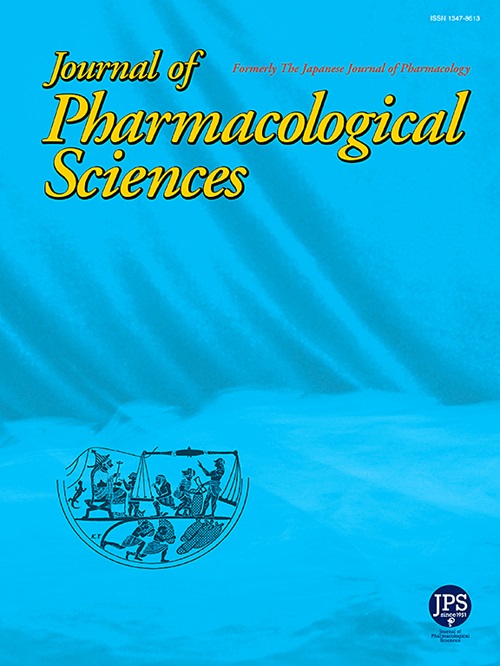暴露于锌诱导的帕金森病样非运动和运动症状与氧化/亚硝化应激介导的黑腹果蝇大脑神经变性有关
IF 2.9
3区 医学
Q2 PHARMACOLOGY & PHARMACY
引用次数: 0
摘要
帕金森病(PD)是第二常见的特发性神经退行性疾病,其特征是黑质致密部多巴胺能神经元的丧失,导致运动障碍。尽管进行了广泛的研究,但PD的病因仍不清楚,现有的药理学评估实验模型并不能完全复制该疾病的特征,因此需要开发一种具有成本效益且可靠的替代方法。近年来,黑腹果蝇已被用作多种神经退行性疾病的模式生物,包括帕金森病。本研究旨在建立一种可靠的锌(Zn+2)在果蝇体内的PD模型。长期暴露于20 mM Zn+2环境7天,成年果蝇表现出非运动和运动pd样症状,运动活动减少,表明运动功能缺陷,嗅觉功能和求偶行为减少,表明非运动功能缺陷。这些行为症状与多巴胺水平下降有关。此外,慢性Zn+2暴露导致果蝇脑膜脂过氧化增强和内源性抗氧化剂水平降低。这些作用主要通过氧化/亚硝化应激途径介导。因此,Zn2+诱导的果蝇PD可以作为一种具有成本效益的药物发现模型,促进潜在治疗化合物的筛选。此外,该模型为研究PD病理生理的分子机制提供了一个有价值的平台。本文章由计算机程序翻译,如有差异,请以英文原文为准。

Exposure of Zinc-induced Parkinson's disease-like non-motor and motor symptoms in relation to oxidative/nitrosative stress mediated neurodegeneration in the brain of Drosophila melanogaster
Parkinson's disease (PD) is the second most prevalent idiopathic neurodegenerative disorder, characterized by the loss of dopaminergic neurons in the substantia nigra pars compacta, leading to locomotor impairment. Despite extensive research, the etiology of PD remains unclear, and existing experimental models for pharmacological evaluation do not fully replicate the disease's hallmarks, necessitating the development of a cost-effective and reliable alternative. In recent past, Drosophila melanogaster has been utilized as a model organism for various neurodegenerative diseases, including PD. The present study was conceptualized to develop a reliable PD model in the Drosophila by Zinc (Zn+2).Chronic exposure to 20 mM Zn+2 for 7 days exhibited non-motor and motor PD-like symptoms in adult Drosophila flies, with reduced locomotory activity, indicating motor function deficit and reduced olfactory function and courtship behavior, indicating a deficit in non-motor function. These behavioral symptoms were associated with decreased dopamine levels. Furthermore, chronic Zn+2 exposure resulted in enhanced membrane lipid peroxidation and decreased endogenous antioxidants level in the Drosophila brain. These effects were primarily mediated by oxidative/nitrosative stress pathway. Thus, Zn2+-induced PD in Drosophila serves as a cost-effective model for drug discovery, facilitating the screening of potential therapeutic compounds. Additionally, this model offers a valuable platform to investigate the molecular mechanisms underlying PD pathophysiology.
求助全文
通过发布文献求助,成功后即可免费获取论文全文。
去求助
来源期刊
CiteScore
6.20
自引率
2.90%
发文量
104
审稿时长
31 days
期刊介绍:
Journal of Pharmacological Sciences (JPS) is an international open access journal intended for the advancement of pharmacological sciences in the world. The Journal welcomes submissions in all fields of experimental and clinical pharmacology, including neuroscience, and biochemical, cellular, and molecular pharmacology for publication as Reviews, Full Papers or Short Communications. Short Communications are short research article intended to provide novel and exciting pharmacological findings. Manuscripts concerning descriptive case reports, pharmacokinetic and pharmacodynamic studies without pharmacological mechanism and dose-response determinations are not acceptable and will be rejected without peer review. The ethnopharmacological studies are also out of the scope of this journal. Furthermore, JPS does not publish work on the actions of biological extracts unknown chemical composition.

 求助内容:
求助内容: 应助结果提醒方式:
应助结果提醒方式:


